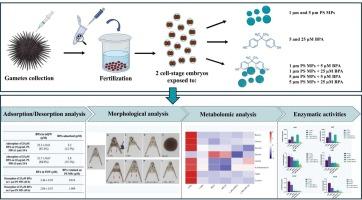Embryotoxicity of polystyrene microplastics, alone and conjugated with bisphenol A, in the black sea urchin Arbacia lixula: A multi-biomarker approach
IF 11.3
1区 环境科学与生态学
Q1 ENGINEERING, ENVIRONMENTAL
引用次数: 0
Abstract
The widespread occurrence of microplastics (MPs) and endocrine-disrupting compounds as bisphenol A (BPA) poses risks to aquatic life. This study evaluates the effects of polystyrene (PS) MPs and BPA, individually and conjugated, on embryonic development of black sea urchin Arbacia lixula, an ecologically relevant bioindicator. Embryos were exposed to 1 and 5 µm PS MPs (10 µg/mL), BPA (5 and 25 µM), and BPA-sorbed PS MPs. A multi-endpoint approach was employed, integrating embryotoxicity assays, morphological evaluation, metabolomics, and enzymatic biomarkers of oxidative stress and neurotoxicity. Size-dependent accumulation of PS MPs was observed. BPA caused pronounced skeletal abnormalities and developmental arrest, whereas when adsorbed onto MPs exhibited mitigated toxicity, even with a higher internalization of particles. Metabolomics revealed significant alterations in neuromodulatory, energetic, and osmoregulatory pathways in all treatments. Similarly, enzymatic assays indicated redox imbalance and inhibited acetylcholinesterase activity. While both PS MPs and BPA, alone and conjugated, induced impaired embryogenesis, no synergistic effect between the toxicants was observed, likely due to the low sorption capacity of BPA on PS MPs. The absence of a synergistic effect between PS MPs and BPA suggests that, under the tested acute exposure conditions, microplastics may modulate rather than exacerbate BPA toxicity. Nonetheless, their co-occurrence can influence exposure routes and developmental processes, with relevant ecological implications for marine invertebrate early life stages. Therefore, even weak and transient particle-pollutant interactions can modulate contaminant behaviour and toxicity, reinforcing the need to incorporate adsorption/desorption dynamics rather than mixture scenarios into environmental hazard assessments of emerging pollutants.

聚苯乙烯微塑料,单独和与双酚A结合,在黑海胆中的胚胎毒性:一种多生物标志物方法
微塑料(MPs)和双酚A (BPA)等内分泌干扰化合物的广泛存在对水生生物构成了威胁。本研究评价了聚苯乙烯(PS) MPs和双酚a对黑海胆(Arbacia lixula)胚胎发育的影响,这是一种生态相关的生物指标。胚胎分别暴露于1和5 µm PS MPs(10 µg/mL)、BPA(5和25 µm)和BPA吸附的PS MPs中。采用多终点方法,结合胚胎毒性试验、形态学评估、代谢组学和氧化应激和神经毒性的酶生物标志物。观察到PS MPs的大小依赖性积累。BPA引起明显的骨骼异常和发育停滞,而当被吸附到MPs上时,即使颗粒内化程度较高,毒性也会减轻。代谢组学揭示了所有治疗中神经调节、能量和渗透调节通路的显著改变。同样,酶分析表明氧化还原失衡和抑制乙酰胆碱酯酶活性。虽然PS MPs和BPA(单独或偶联)均可诱导胚胎发育受损,但未观察到两者之间的协同效应,这可能是由于BPA对PS MPs的吸附能力较低。PS - MPs和BPA之间不存在协同效应,这表明在测试的急性暴露条件下,微塑料可能会调节而不是加剧BPA的毒性。尽管如此,它们的共存可以影响暴露途径和发育过程,并对海洋无脊椎动物的早期生命阶段产生相关的生态影响。因此,即使是微弱和短暂的颗粒-污染物相互作用也可以调节污染物的行为和毒性,从而加强了将吸附/解吸动力学而不是混合情景纳入新出现污染物的环境危害评估的必要性。
本文章由计算机程序翻译,如有差异,请以英文原文为准。
求助全文
约1分钟内获得全文
求助全文
来源期刊

Journal of Hazardous Materials
工程技术-工程:环境
CiteScore
25.40
自引率
5.90%
发文量
3059
审稿时长
58 days
期刊介绍:
The Journal of Hazardous Materials serves as a global platform for promoting cutting-edge research in the field of Environmental Science and Engineering. Our publication features a wide range of articles, including full-length research papers, review articles, and perspectives, with the aim of enhancing our understanding of the dangers and risks associated with various materials concerning public health and the environment. It is important to note that the term "environmental contaminants" refers specifically to substances that pose hazardous effects through contamination, while excluding those that do not have such impacts on the environment or human health. Moreover, we emphasize the distinction between wastes and hazardous materials in order to provide further clarity on the scope of the journal. We have a keen interest in exploring specific compounds and microbial agents that have adverse effects on the environment.
 求助内容:
求助内容: 应助结果提醒方式:
应助结果提醒方式:


